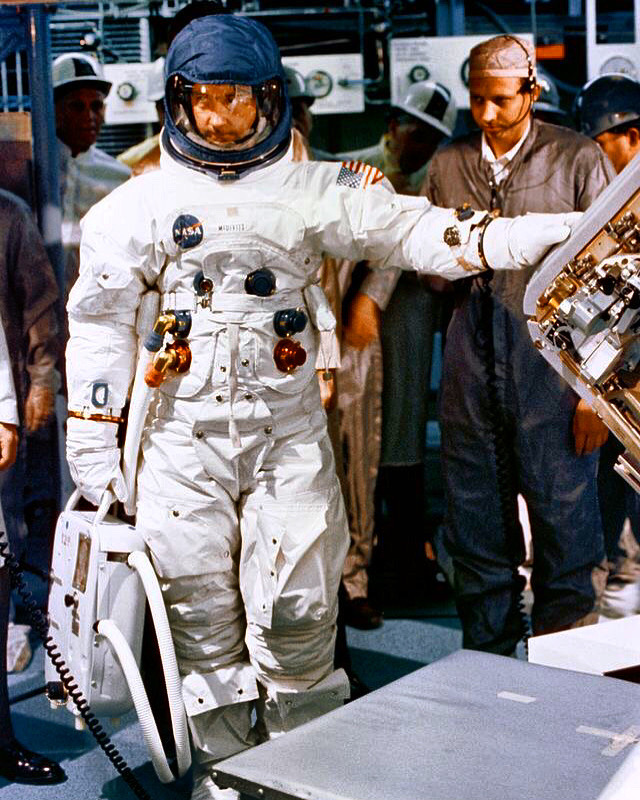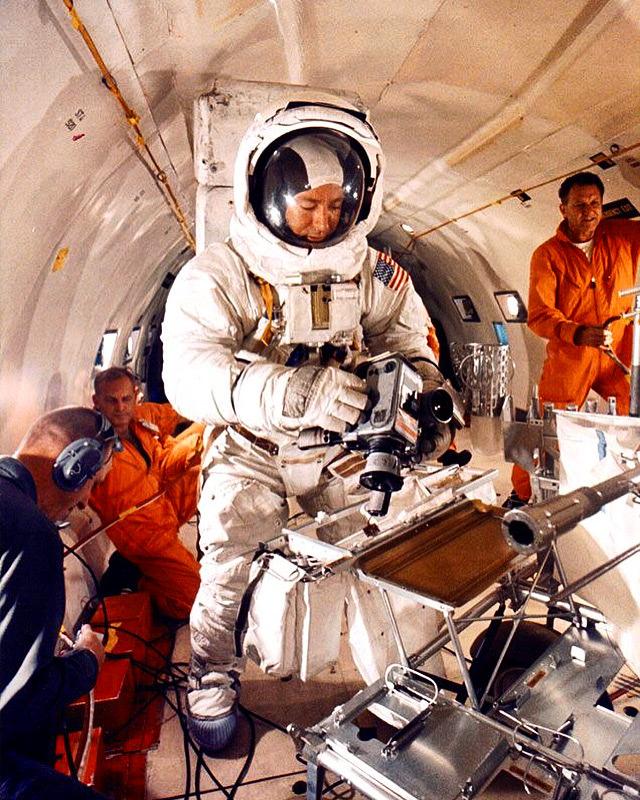#space travel

Apollo 11 astronauts Neil Armstrong, Michael Collins & Buzz Aldrin. In Feb 1968, NASA announced 5 potential landing sites for A11’s Lunar Lander, ‘Eagle’. These 5 spots were chosen following research by 5 unmanned lunar orbital missions & Surveyor landing missions. Among these 5 potential spots, 2 were in the Sea of Tranquility. In May ‘69, Apollo 10 flew within 9.3 miles of A11’s future landing site in Tranquility & deemed it acceptable.

Astronauts on a cloudy day. Alan Bean, Pete Conrad & Richard Gordon hop out of the shuttle bus & step towards the 363-foot tall Saturn V rocket in preparation for Apollo 12, Nov 1969. Conrad & Bean spent 31 hours on the lunar surface while Gordon orbited 45 times above in the Command Module. The spacecraft was nearly identical to that of Apollo 11 with the exception being that hammocks were added to the Lunar Module so that Bean & Conrad could rest more comfortably when not out moonwalking. The mission lasted a total of 10 days & 4 hours.

A relaxed astronaut. Stuart Roosa takes a moment during preparations for Apollo 14, Jan 1971. Mr. Roosa flew ‘Kitty Hawk’, the Command Module for the mission & orbited the moon 34 times as crew mates Edgar Mitchell & Alan Shephard walked on the moon. Roosa was 1 of 19 astronauts chosen in Group 5 by NASA in 1966. Following A14, he served as backup Command Module Pilot for Apollo 16 & 17.

Flying in Skylab 3. Alan Bean moves about America’s first space station via a maneuvering unit. The July 1973 mission was the 2nd crewed flight to the space station. Bean, Owen Garriott & Jack Lousma were launched within the Apollo Command & Service Module situated atop a Saturn 1B rocket. It was the rookie spaceflight for Garriott & Lousma & the 2nd & final flight for Bean. The mission lasted a total of 59 days. The dome within which Bean moves is 19 feet in height & 22 feet in diameter.

Early sketch of ‘The Astronot’ movie poster by artist John Keane. It was quite beautiful to see this early rendering & its relation to the finished artwork. The Oregon-shot work set in the 1960s streams on @primevideo in the USA & UK (& perhaps other countries I’m not aware of at the moment) via the profile link or below. The 72-minute independent film was shot in Bend & La Pine by FFE Films director Tim Cash & written by Vancouver screenwriter @pennanbrae. The soundtracks for the film also stream on @spotify & @applemusic. If seeking some weekend viewing & have a chance to tune in, thanks very much for sharing your time with it.

We have lift off! Frank Borman & James Lovell blast off for their rookie spaceflight in Gemini 7, Dec 1965. The pair orbited Earth 206 times during their 14 days in space in their tiny Gemini capsule. It was the world’s longest spaceflight until Jun 1970 when Soyuz 9 broke it. G7 also achieved the first rendezvous between 2 spacecraft as Gemini 6A with Wally Schirra &
Tom Stafford came within 1 foot of G7 & could have docked had the crafts been equipped to do so. Ed White & Michael Collins served as backup for G7.

Where’s my drill? Astronaut David Scott retrieves a drill off the lunar surface during Apollo 15, Aug 1971. The mission was the first with the LRV (lunar rover vehicle). Mr. Scott was the 7th to walk on the moon & first to drive when he got behind the wheel of the LRV. He wa chosen in the 3rd Group of astronauts in 1963 & flew with Neil Armstrong on the historic & perilous Gemini 8 mission of 1966. He also flew on the 10-day Apollo 9 flight in 1969. David walked on the moon with James Irwin on A15 while Al Worden orbited above in the Command Module. The pair spent 18.5 hours on EVAs while on the moon’s surface & brought back 170lbs of moon rocks home.

Astronauts Jim Lovell & Fred Haise prepare for Apollo 13, Feb 1970. Mr. Haise was chosen in the 5th group of astronauts in 1966. Besides A13, he flew 5 Space Shuttle Approach & Landing Tests during the early days of the Shuttle Program in 1977. Mr. Lovell was chosen in 1962 in the 2nd Group of astronauts & flew on Gemini 7, 12 & Apollo 8 & 13. An excellent film on the Apollo 13 mission is Ron Howard’s fantastic, award-winning film.

Standing by. Astronaut James McDivitt readies for training during preparation for Apollo 9. Mr. McDivitt first flew on Gemini 4 with Ed White on a historic space flight in which White became the first American to space walk. Apollo 9 was a 10-day flight which McDivitt commanded and the first to employ the full Apollo spacecraft (the Lunar Module & Command & Service Modules). A9 was also the 2nd crewed flight with the Saturn V rocket. McDivitt was part of the Group 2 of astronauts selected in 1962.

Have camera, will travel. Apollo 12 astronaut Alan Bean does some work with the Hasselblad camera in preparation for the 2nd mission to land on the moon. Mr. Bean, chosen in the 3rd Group of astronauts by NASA in 1963, became the 4th person to walk on the moon during the Nov 1969 mission. He was 37 years old at the time. 4 years after A12, he flew on Skylab 3 in July 1973 on a mission which lasted 59 days. Also an accomplished painter, Bean created space-themed paintings of his adventures & of his fellow astronauts.

Currently seated, soon to fly. Pete Conrad & Richard Gordon take a load off their feet prior to their near 3-day Gemini 11 mission, Sept 1966. The pair performed the 1st ever direct-ascent rendezvous with an AGT (Agena Target Vehicle) as they docked with it just 94 minutes after launch (& during the 1st orbit). Gordon also performed a pair of EVAs on the mission for a total of 2 hours & 41 min. The duo went on to fly to the moon together during Apollo 12 in Nov 1969. Conrad became the 3rd human to walk on the lunar surface on the mission while Gordon orbited above in the Command Module. A historic pair of astronauts.

Relaxing after the mission. Astronaut John Glenn kicks back following his historic Project Mercury flight to become the 1st American to orbit the globe. His 5 hour flight in Feb ‘62 orbited Earth 3x before splashdown. Russian cosmonaut Yuri Gagarin was both the 1st human in space & to orbit the globe in his Vostok craft in April ‘61. Glenn continued his NASA career to accomplish the formidable feat of being the oldest in space, at that time, at 77 years of age during a Space Shuttle Discovery flight in 1995; a true space pioneer & legend.

In the field today, on the moon tomorrow. Charlie Duke & John Young undertake geology training for Apollo 16 in Sudbury, Ontario, 07/71. The city in Northern Ontario, nicknamed ‘The Nickel City’, was chosen due to the area’s shatter cone formations. The pair landed in the Descartes Highlands upon the lunar surface in April the following year. They spent 71 hours on the moon & brought back ‘Big Mule’, for research; the largest moon rock collected during Project Apollo.

Suited & ready. Frank Borman trains for his space age marathon mission with astronaut Jim Lovell on Gemini 7, Dec 1965. The pair set a space endurance record at the time; 14 days in space in a tiny Gemini capsule; about ½ the size of a VW Beetle. Mr. Borman later went on to fly with Lovell & William Anders on the historic first lunar orbit via Apollo 8 in Dec 1968. Chosen in the Next Nine (2nd Group of astronauts in 1962), Borman was also the NASA liaison to the White House during Apollo 11 & watched the moon landing mission with President Nixon.

Astronaut thru a window. Buzz Aldrin prepares for Gemini 12, Nov 1966. The mission marked the end of Project Gemini. The first crewed launch of the Gemini Program began in March 1965 with Gus Grissom & John Young via Gemini 3. The spacewalks by Mr. Aldrin on Gemini’s final mission demonstrated an astronaut could work outside the spacecraft for extended periods of time. New handles on the outside of the craft & the introduction of underwater training assisted in improving an astronaut’s EVA ability. Buzz became a pioneer in extended spacewalks; his 3 EVAs on G12 totalled 5.5 hours. Becoming the 2nd human to walk on the moon 3 years later during Apollo 11 further cemented his legacy.

Some space age reading material. A brilliant & colourful cover depicting the passion of the space race between the USA & USSR courtesy Time Magazine, Dec 6, 1968. Later that month, NASA would win the race to a crewed lunar orbit via Apollo 8 & astronauts James Lovell, Frank Borman & William Anders. Such an exciting decade of historic firsts.

3 peas in a pod. Frank Borman sits in the commander’s seat to the left, with William Anders to the right & Michael Collins in the middle during flight simulator training for Apollo 8. Mr. Collins developed a back injury in 1968 which led to James Lovell replacing him on the 1st crewed flight to orbit the moon. All was not lost for Mike though as he was bumped back to Apollo 11 with Neil Armstrong & Buzz Aldrin for the first human landing on the moon. Not too bad of a second assignment.

Dynamic duo. Astronauts John Young & Gus Grissom stand by ‘Molly Brown’, their Gemini 3 capsule aboard the USS Intrepid following their successful flight. The March 1963 mission completed 3 orbits about Earth & was the first duo space flight by NASA & first crewed flight of Project Gemini. The flight lasted 4 hours & 52 minutes. Backup crew for the mission were Wally Schirra & Tom Stafford. The original crew were to be Alan Shepard & Stafford until an inner ear disorder grounded Shepard. He’d have to wait until Apollo 14 when he got to walk on the moon at 47 years of age. Something nice to look forward to.

Space legend. Cosmonaut Valentina Tereshkova became the first woman in space when she flew Vostok 6 in June 1963. The solo flight orbited Earth 48 times over a 2-day, 23 hour mission. She was selected from 400 applicants & it was her only spaceflight. She is the only woman ever to fly a solo space mission & in 2013 offered to go on a 1-way trip to Mars if the opportunity popped up. She flew at the age of 25 & remains the youngest woman to have flown in space.

Edgar Mitchell has the @hasselblad camera in hand during zero gravity training in preparation for Apollo 14. Mitchell served as Lunar Module Pilot on the mission with Commander Alan Shepard & Command Module Pilot Stuart Roosa & became the 6th human to walk on the moon. Mitchell graduated in the 5th Group of astronauts in 1966 & served as support crew for Apollo 9 & backup LMP for A10. The Apollo 14 crew was to fly the Apollo 13 mission, but additional time was needed for Shepard to train as he was recovering from Ménière’s Disease. Mitchell later served as backup LMP for Apollo 16. A space legend of the early 1970s.
